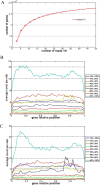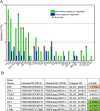Transcriptome analysis of lateral buds from Phyllostachys edulis rhizome during germination and early shoot stages
- PMID: 32448144
- PMCID: PMC7245953
- DOI: 10.1186/s12870-020-02439-8
Transcriptome analysis of lateral buds from Phyllostachys edulis rhizome during germination and early shoot stages
Abstract
Background: The vegetative growth is an important stage for plants when they conduct photosynthesis, accumulate and collect all resources needed and prepare for reproduction stage. Bamboo is one of the fastest growing plant species. The rapid growth of Phyllostachys edulis results from the expansion of intercalary meristem at the basal part of nodes, which are differentiated from the apical meristem of rhizome lateral buds. However, little is known about the major signaling pathways and players involved during this rapid development stage of bamboo. To study this question, we adopted the high-throughput sequencing technology and compared the transcriptomes of Moso bamboo rhizome buds in germination stage and late development stage.
Results: We found that the development of Moso bamboo rhizome lateral buds was coordinated by multiple pathways, including meristem development, sugar metabolism and phytohormone signaling. Phytohormones have fundamental impacts on the plant development. We found the evidence of several major hormones participating in the development of Moso bamboo rhizome lateral bud. Furthermore, we showed direct evidence that Gibberellic Acids (GA) signaling participated in the Moso bamboo stem elongation.
Conclusion: Significant changes occur in various signaling pathways during the development of rhizome lateral buds. It is crucial to understand how these changes are translated to Phyllostachys edulis fast growth. These results expand our knowledge on the Moso bamboo internodes fast growth and provide research basis for further study.
Keywords: Alternative splicing; DELLA protein; GA; Phyllostachys edulies; Phytohormone; RNA-Seq; Rhizome lateral bud.
Conflict of interest statement
The authors declare that they have no competing interests.
Figures










Similar articles
-
Association among starch storage, metabolism, related genes and growth of Moso bamboo (Phyllostachys heterocycla) shoots.BMC Plant Biol. 2021 Oct 20;21(1):477. doi: 10.1186/s12870-021-03257-2. BMC Plant Biol. 2021. PMID: 34670492 Free PMC article.
-
A new outlook on sporadic flowering of bamboo.Plant Signal Behav. 2017 Jul 3;12(7):e1343780. doi: 10.1080/15592324.2017.1343780. Epub 2017 Jun 26. Plant Signal Behav. 2017. PMID: 28650217 Free PMC article.
-
Transcriptome sequencing and analysis of the fast growing shoots of moso bamboo (Phyllostachys edulis).PLoS One. 2013 Nov 7;8(11):e78944. doi: 10.1371/journal.pone.0078944. eCollection 2013. PLoS One. 2013. PMID: 24244391 Free PMC article.
-
Characterization of the floral transcriptome of Moso bamboo (Phyllostachys edulis) at different flowering developmental stages by transcriptome sequencing and RNA-seq analysis.PLoS One. 2014 Jun 10;9(6):e98910. doi: 10.1371/journal.pone.0098910. eCollection 2014. PLoS One. 2014. PMID: 24915141 Free PMC article.
-
Transcriptomic Complexity of Culm Growth and Development in Different Types of Moso Bamboo.Int J Mol Sci. 2023 Apr 18;24(8):7425. doi: 10.3390/ijms24087425. Int J Mol Sci. 2023. PMID: 37108588 Free PMC article. Review.
Cited by
-
Environmental drivers and transcriptomic variations shaping Lei bamboo shoots across cultivation regions.Front Plant Sci. 2025 Apr 1;16:1565665. doi: 10.3389/fpls.2025.1565665. eCollection 2025. Front Plant Sci. 2025. PMID: 40235921 Free PMC article.
-
Silencing of SlDRB1 gene reduces resistance to tomato yellow leaf curl virus (TYLCV) in tomato (Solanum lycopersicum).Plant Signal Behav. 2022 Dec 31;17(1):2149942. doi: 10.1080/15592324.2022.2149942. Plant Signal Behav. 2022. PMID: 36453197 Free PMC article.
-
Total and Mitochondrial Transcriptomic and Proteomic Insights into Regulation of Bioenergetic Processes for Shoot Fast-Growth Initiation in Moso Bamboo.Cells. 2022 Apr 6;11(7):1240. doi: 10.3390/cells11071240. Cells. 2022. PMID: 35406802 Free PMC article.
-
New Insights Into the Local Auxin Biosynthesis and Its Effects on the Rapid Growth of Moso Bamboo (Phyllostachys edulis).Front Plant Sci. 2022 May 3;13:858686. doi: 10.3389/fpls.2022.858686. eCollection 2022. Front Plant Sci. 2022. PMID: 35592571 Free PMC article.
-
All-Year High IAA and ABA Contents in Rhizome Buds May Contribute to Natural Four-Season Shooting in Woody Bamboo Cephalostachyum pingbianense.Plants (Basel). 2024 Jan 30;13(3):410. doi: 10.3390/plants13030410. Plants (Basel). 2024. PMID: 38337943 Free PMC article.
References
-
- Beveridge CA, Mathesius U, Rose RJ, Gresshoff PM. Common regulatory themes in meristem development and whole-plant homeostasis. Curr Opin Plant Biol. 2007;10(1):44–51. - PubMed
-
- Fu J. Chinese moso bamboo: its importance. Bamboo. 2001;22(5):5–7.
-
- Erfa ZYHWQ, Liguang C. Hormone content and distribution in Phyllostachys heterocycla cv. pubescens during period of shoot emergence. Sci Silvae Sin. 1998;S1..
-
- He X-Q, Suzuki K, Kitamura S, Lin J-X, Cui K-M, Itoh T. Toward understanding the different function of two types of parenchyma cells in bamboo culms. Plant Cell Physiol. 2002;43(2):186–195. - PubMed
-
- Li X, Shupe T, Peter G, Hse C, Eberhardt T. Chemical changes with maturation of the bamboo species Phyllostachys pubescens. J Trop For Sci. 2007;19(1):6.
MeSH terms
Substances
Grants and funding
LinkOut - more resources
Full Text Sources

